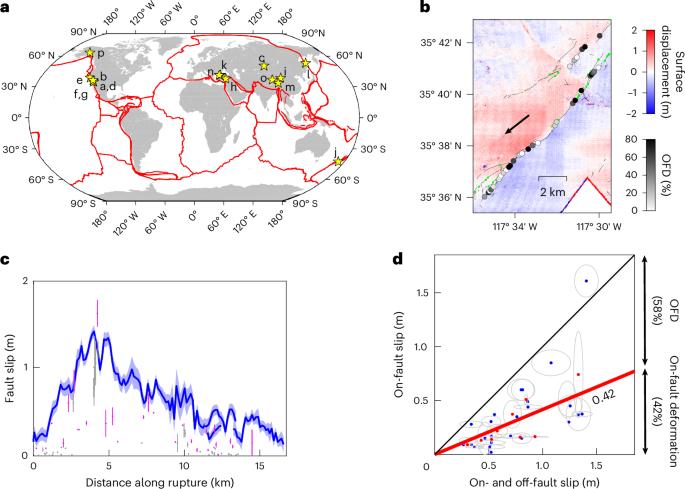Localization of inelastic strain with fault maturity and effects on earthquake characteristics
IF 16.1
1区 地球科学
Q1 GEOSCIENCES, MULTIDISCIPLINARY
引用次数: 0
Abstract
Coseismic ruptures release stored elastic strain through a combination of shear displacement along localized, principal faults and distributed bulk inelastic failure of the surrounding material. How inelastic strain localizes as fault systems mature and structurally develop is less well understood owing to the difficulty of measuring the complex, near-field and high-strain regions of coseismic surface ruptures. Here we use radar and optical images to measure the near-field surface displacement field and magnitude of off-fault inelastic strain from 16 historic strike-slip earthquakes that occurred on faults with cumulative displacements and fault slip rates that span almost three orders of magnitude. We show that inelastic shear deformation does localize as fault systems mature: the magnitude of off-fault inelastic strain is largest (34–67%) for fault systems with the lowest cumulative displacements (<3 km) and then rapidly decays to values that saturate around 13–19% for the most ‘mature’ fault systems with cumulative displacements exceeding ~20 km. We find that more localized coseismic ruptures host faster ruptures, generate fewer aftershocks and occur along geometrically simpler fault networks. Ruptures on more structurally mature faults are more localized and therefore expected to host faster ruptures with less off-fault deformation, according to remote-sensing and field measurements from historic strike-slip earthquakes.


非弹性应变随断层成熟度的局部化及其对地震特征的影响
同震破裂通过沿局部主断层的剪切位移和周围材料的分布体非弹性破坏的组合释放储存的弹性应变。随着断层系统的成熟和结构的发展,非弹性应变是如何局部化的,由于测量同震地表破裂的复杂、近场和高应变区域的困难,人们还不太清楚。在这里,我们使用雷达和光学图像来测量发生在断层上的16次历史走滑地震的近场地表位移场和断层非弹性应变的大小,这些地震的累积位移和断层滑动率几乎跨越了三个数量级。研究表明,非弹性剪切变形确实会随着断层系统的成熟而局部化:对于累积位移最小(3 km)的断层系统,断层外非弹性应变的大小最大(34-67%),然后对于累积位移超过~20 km的最“成熟”断层系统,非弹性应变的大小迅速衰减到13-19%左右饱和。我们发现,更局部的同震破裂会导致更快的破裂,产生更少的余震,并且沿着几何上更简单的断层网发生。
本文章由计算机程序翻译,如有差异,请以英文原文为准。
求助全文
约1分钟内获得全文
求助全文
来源期刊

Nature Geoscience
地学-地球科学综合
CiteScore
26.70
自引率
1.60%
发文量
187
审稿时长
3.3 months
期刊介绍:
Nature Geoscience is a monthly interdisciplinary journal that gathers top-tier research spanning Earth Sciences and related fields.
The journal covers all geoscience disciplines, including fieldwork, modeling, and theoretical studies.
Topics include atmospheric science, biogeochemistry, climate science, geobiology, geochemistry, geoinformatics, remote sensing, geology, geomagnetism, paleomagnetism, geomorphology, geophysics, glaciology, hydrology, limnology, mineralogy, oceanography, paleontology, paleoclimatology, paleoceanography, petrology, planetary science, seismology, space physics, tectonics, and volcanology.
Nature Geoscience upholds its commitment to publishing significant, high-quality Earth Sciences research through fair, rapid, and rigorous peer review, overseen by a team of full-time professional editors.
 求助内容:
求助内容: 应助结果提醒方式:
应助结果提醒方式:


